Geothermal energy systems offer a sustainable and efficient solution for heating and cooling homes, leveraging the constant temperatures beneath the Earth’s surface. Precision Comfort Systems, with our extensive experience in geothermal loop design in Hamilton County, Central Indiana, are leaders in this innovative field. But what exactly does “geothermal loop design” entail, and how does it contribute to your home’s energy efficiency?
The Basics of Geothermal Loops
At its core, a geothermal system consists of a heat pump and a network of pipes, known as the geothermal loop, buried underground or submerged in water. This loop is essential for transferring heat between your home and the ground, exploiting the Earth’s stable underground temperatures. There are two primary types of geothermal loops: open and closed.
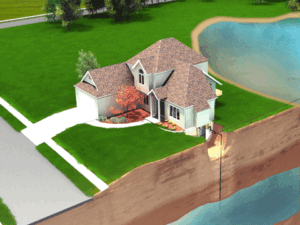
Open Loop Systems: These systems utilize groundwater from a well or a body of water as a direct energy source. Water is pumped from the source, circulates through the geothermal heat pump to exchange heat, and is then discharged back into the ground or water body. While cost-effective, open loop systems depend heavily on water quality and availability, making them suitable only in areas with abundant, clean groundwater.
Closed Loop Systems: These are more common and versatile, consisting of a continuous piping loop filled with a heat transfer fluid. The fluid circulates in a closed circuit, absorbing heat from the ground in winter and transferring heat back into the ground in summer. A closed loop system can be further categorized based on configuration and installation method.
Types of Closed Loop Systems
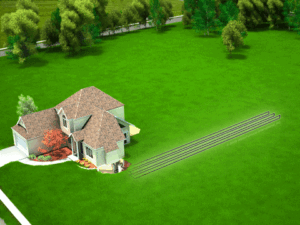
Horizontal Loops: Ideal for properties with sufficient land area, horizontal loops involve burying pipes in trenches about 6 to 10 feet deep. To maximize space efficiency, the pipes can be laid straight or in a “slinky” pattern. This setup is typically more cost-effective but requires a large, unobstructed area for installation.
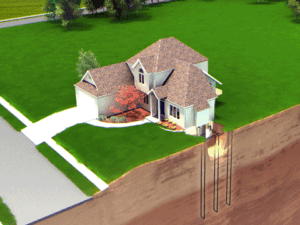
Vertical Loops: Vertical loops are the go-to solution when land space is limited. These involve drilling boreholes 100 to 500 feet deep into the ground, with pipes inserted vertically and connected at the bottom with a U-bend. Although more expensive due to drilling costs, vertical loops are ideal for urban or suburban areas with limited yard space.
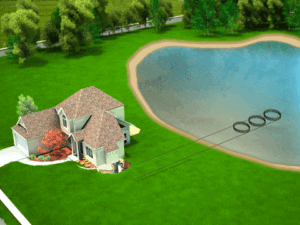
Pond (Lake) Loops: If a property has access to a large, deep pond or lake, pond loops can be an economical and efficient option. Coils of pipe are submerged at least 8 feet deep to prevent freezing. This method eliminates the need for extensive excavation or drilling, making it a cost-effective choice for properties with suitable water bodies nearby.
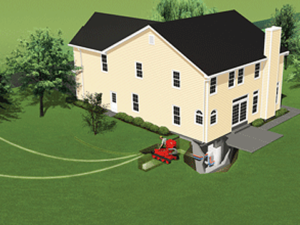
Directional Bore Loops: This method is similar to vertical loops but uses directional boring technology, which allows for the precise installation of loops under existing structures or landscapes with minimal disruption. This technology is increasingly popular for retrofits and areas with existing infrastructure.
Precision in Geothermal Loop Design
Designing and installing a geothermal loop requires expertise to ensure maximum efficiency and reliability. Precision Comfort Systems excels in this field, offering customized solutions tailored to the specific needs of your property.
Efficient geothermal loop design includes several critical steps:
- Site Assessment: Evaluating soil conditions, land area, and water availability.
- System Sizing: Calculating the heating and cooling loads to determine the appropriate loop size.
- Loop Configuration: Choosing the best loop type based on the site assessment.
- Installation: Properly installing the loop to ensure optimal performance and longevity.
Key Considerations:
- Soil Conductivity: Higher conductivity soils transfer heat more efficiently.
- Land Availability: Determines whether horizontal or vertical loops are more feasible.
- Water Quality and Supply: Critical for open loop systems to function effectively.
Advantages of Geothermal Loops
Geothermal loops offer numerous benefits, making them a compelling choice for homeowners seeking sustainable and efficient heating and cooling solutions.
- Energy Efficiency: Geothermal systems can achieve 300-600% efficiencies, meaning they produce three to six times more energy than they consume. Energy efficiency translates to significant savings on utility bills.
- Environmental Impact: By leveraging renewable geothermal energy, these systems reduce greenhouse gas emissions and dependence on fossil fuels, contributing to a greener planet.
- Longevity and Reliability: Geothermal loops are designed to last 50 years or more, providing a long-term, reliable home heating and cooling solution.
- Consistent Comfort: Geothermal systems maintain consistent indoor temperatures regardless of external weather conditions, enhancing overall home comfort.
Geothermal loop design is a sophisticated and essential component of efficient geothermal heating and cooling systems. Whether horizontal, vertical, pond, or directional bore loop, each design offers unique advantages tailored to different property types and conditions. With Precision Comfort Systems’ extensive experience and commitment to excellence, Indiana homeowners can trust that their geothermal systems will deliver optimal performance, energy savings, and environmental benefits for years to come.
For more information on geothermal systems and to explore the best options for your home, visit Precision Comfort Systems or contact us at 317-867-2665.
